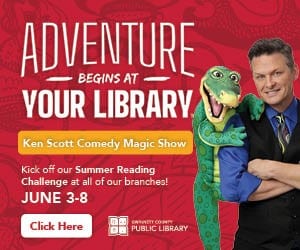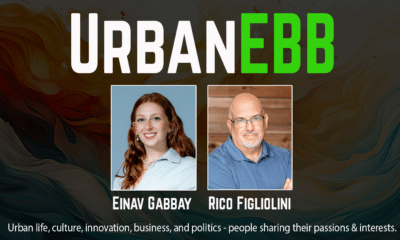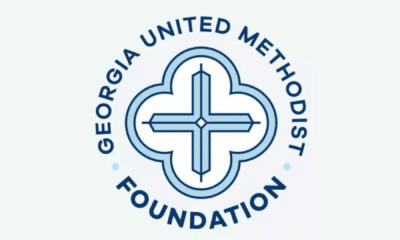Business
ASHRAE: Changing the value of a building and setting standards for the world
Published
3 years agoon
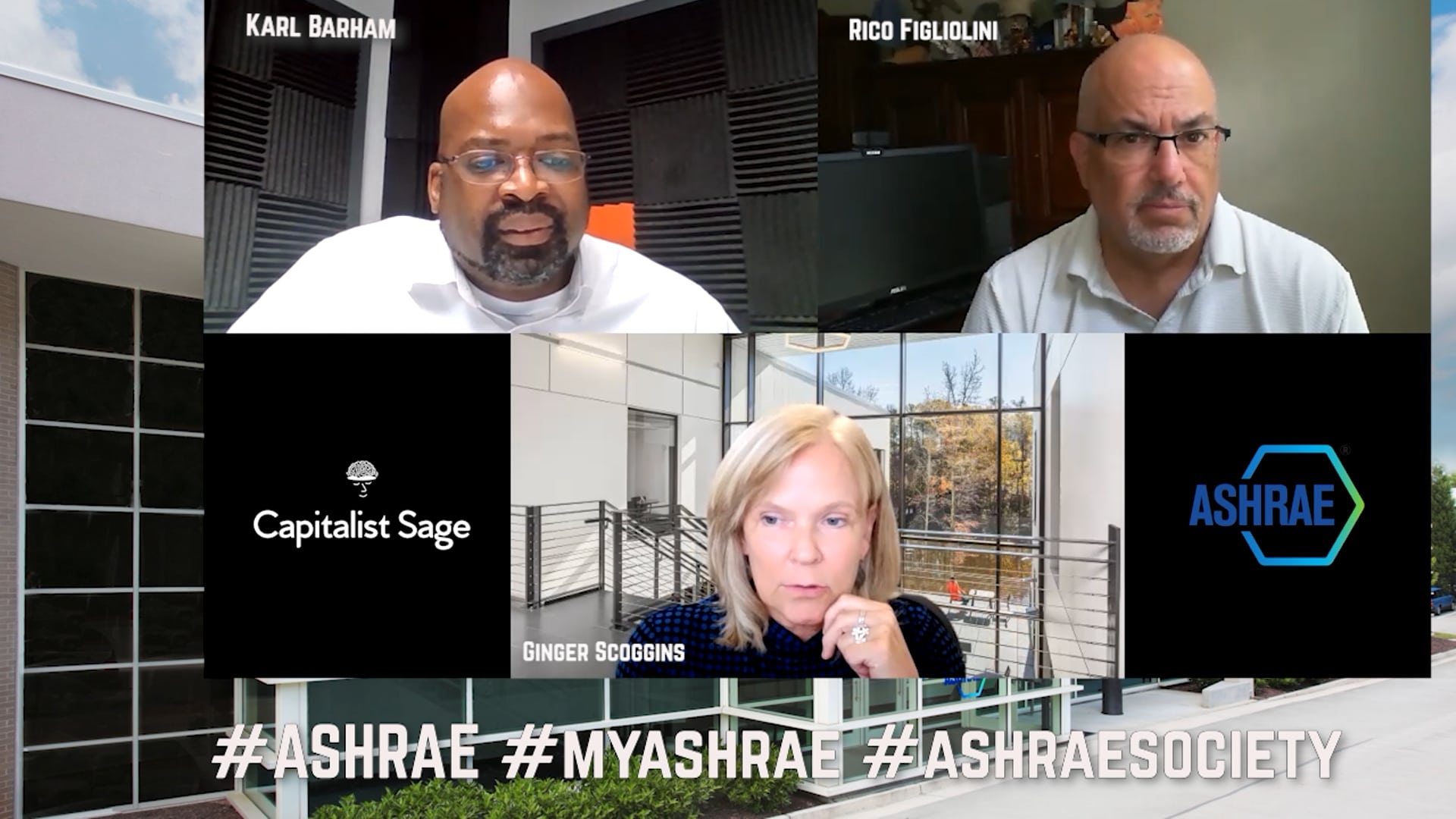
ASHRAE, and the engineers that make up its society, are responsible for setting the standard of building in the United States and many countries. Today’s guest, Ginger Scoggins, is the current Treasurer and served as chair for the Building Headquarters Ad Hoc Committee at ASHRAE. In addition to her work there, she is also president and co-founder of Engineered Designs, Inc. In this episode, Karl and Rico talk with Ginger about the new ASHRAE Headquarters in Peachtree Corners and this society’s amazing work.
ASHRAE is a global professional society committed to serving humanity by advancing the arts and sciences of heating, ventilation, air conditioning, refrigeration, and their allied fields.
Related Links
ASHRAE Website: https://www.ASHRAE.org
Ginger’s Email: GScoggins@EngineeredDesigns.com
“It’s just hyper important, especially right now in this world we’re in, to make sure that the standards that people need to adhere to when they’re designing buildings really help the occupants and the planet. And that we’re not contributing to the issues that we see today in terms of global warming and all of that.”
Ginger Scoggins
Podcast transcript:
[00:00:30] Karl: Hello. Today we’re speaking with ASHRAE and talking about advances in building technologies here in Peachtree Corners. Our guest will be Ginger Scoggins, ASHRAE Treasurer and Fellow, and the chair of the ASHRAE Building Headquarters Ad Hoc committee. And president of Engineered Designs Inc. I’d like to welcome everybody to the Capitalist Sage Podcast. We’re here to bring you advice and tips from seasoned pros and experts to help you improve your business. I’m Karl Barham with Transworld business advisors. And my co-host is Rico Figliolini with Mighty Rockets, Digital Marketing, and the publisher of the Peachtree Corners Magazine Rico, how are you doing today?
[00:01:08] Rico: Good, Karl. How are you? Ginger, good to see you.
[00:01:11] Ginger: Good to see you both.
[00:01:13] Karl: Excellent. Why don’t you tell us about our sponsor today?
[00:01:17] Rico: Sure. Peachtree Corners Magazine, which I publish six times a year is the publication that covers Peachtree Corners, not only in print, but online. And we cover it through podcasts, like the Capitalist Sage, Peachtree Corners Life, and even Prime Lunchtime with City Manager. So check us out, go to LivinginPeachtreeCorners.com and you’ll find out more information.
[00:01:37] Karl: Thank you so much for that. It is a pleasure to welcome Ginger Scoggins a member of ASHRAE and the current Treasurer. She’s also a Fellow with ASHRAE and the Chair of the building HQ Ad Hoc Committee for ASHRAE that helped build and design the new ASHRAE headquarters right here in Peachtree Corners. She’s also the President of Engineered Designs Inc. out of Raleigh, North Carolina. And a lifelong supporter of engineering buildings and design on the mechanical side. Hi, Ginger, how are you doing today?
[00:02:13] Ginger: Good. How are you Karl?
[00:02:15] Karl: I’m doing fabulous. As we get started in talking about the new headquarters. I’d probably like to just start with us learning a little bit about you and your journey in the business that you’re doing and with ASHRAE.
[00:02:27] Ginger: Sure. So I am a consulting engineer. I’m a mechanical engineer by training. Actually from Tennessee. I went to an engineering school called Tennessee Tech University. I’ve got about 30 years experience designing buildings. Started right out of college and worked for a consulting firm here in Raleigh. Worked for a couple of different firms for the first 10 years and then actually went out on my own about 24 years ago. So I’ve been running this business for 24 years, designing buildings in and around North Carolina, South Carolina area. So focusing on different types of buildings, we do a lot of university work. We do a lot of mission critical work, which is telecommunications or data center type work. And I’ve been an ASHRAE volunteer for almost that entire 30 years. Which ASHRAE is a volunteer driven organization. We have 56,000 plus members across the world. We work on designing and building sustainable buildings, promoting the industry. We write the standards for our industry. Most of the work I do is based on ASHRAE standards. We do write the standards that drive our industry and drive the building code when it comes to energy and indoor air quality. Which is especially important right now with the pandemic going on. The ASHRAE epidemic task force has been hugely instrumental in setting some standards and what to do with buildings. All different types of buildings in terms of outside air quality, how to deal with the pandemic, filtration levels. All of those items are hugely important right now. And always, but especially right now. And so ASHRAE works with all those standards and helps set the stage for how people like me do our job of designing healthy buildings.
[00:04:17] Karl: That’s fabulous. I noticed for folks that don’t know, ASHRAE stands for American Society of Heating, Refrigerating, Air Conditioning Engineer. Did I get that right?
[00:04:27] Ginger: You got that perfect.
[00:04:29] Karl: Oh, excellent. Why don’t you tell folks a little bit about the mission around ASHRAE? Why does such an organization exist and how does it help, you know, people, investors, building owners, build more sustainable, safe, and comfortable buildings.
[00:04:43] Ginger: Well, sure. So ASHRAE whether, you know or don’t know, most states in the country have an energy code. And that energy code is based on ASHRAE standard 90.1 in most instances. And so those standards like 90.1 and ASHRAE 62, which is an outside air requirement standard. Those help us make sure we’re building buildings that are healthy for the people in the building, as well as to conserve energy use, to help our planet. ASHRAE is working really hard right now in the decarbonisation world. And we have a task force for building decarbonisation. On how we can build buildings that use less carbon, reduce our carbon footprint. It’s just hyper important, especially right now in this world we’re in, to make sure that the standards that people need to adhere to when they’re designing buildings really help the occupants and the planet. And that we’re not contributing to the issues that we see today in terms of global warming and all of that.
[00:05:53] Rico: Yeah. It’s interesting. I think that the standards that you set don’t just affect, like what some people might think is just air conditioning, heating. It probably affects the standards of windows that are being installed in buildings, the double pane, the gas, installation of those. There’s a variety of industries actually that ASHRAE effects.
[00:06:12] Ginger: Well, exactly right. And when you’re designing a building, and it’s not just mechanical engineers, such as myself, but architects, electrical engineers. You know, ASHRAE sets those levels of the lighting, light power density that you can put in buildings so you know how much energy you’re using for those. We also set what the U values should be for your walls and your roof in order to meet the energy code and to be 90.1 compliant. In terms of the entire building, ASHRAE standard 90.1 is in our industry, what we use to make sure we have a building that is compliant with energy code.
[00:06:47] Karl: I’ve seen data that shows when you think about energy use in the country, buildings account for anywhere from 20 to 35% of energy use. People think of cars and pollution, or they might think of just industry. But if you think about how many commercial and residential buildings there are in the country, it’s a large contributor of energy use that affects the energy grid itself, as well as global warming. And I know that ASHRAE has been leading the challenge in education for engineers today and in the future on how to be more efficient in their designs, and were able to incorporate that right here in Peachtree Corners and in the headquarter building. How did that come about and how did you get involved in bringing some of that technology to the headquarter building in Peachtree Corners?
[00:07:42] Ginger: So we were actually down the road a little bit in Brookhaven, And had renovated our building in 2010 to be a lead platinum building. And were very happy there, but we started getting surrounded by the new CHOA campus that has gone there. And that’s taken over that entire block if not more right there.
[00:08:06] Karl: Children’s Hospital of Atlanta?
[00:08:08] Ginger: Children’s Hospital of Atlanta, yeah. So as ASHRAE does with anything, we set up a committee. And I was actually an ASHRAE Vice President at the time and was asked to lead that committee to study whether we should stay where we were or move. And wether we should build or renovate or lease. So we took about nine months, I think, to evaluate our building, see what we could get for it, whether it was worth moving. Should we lease, should we buy, should we renovate? We were very fortunate in that process that CHOA offered to buy our building and they offered to buy it at a very good rate. So we made that decision to move. And they also, as part of that deal, allowed us to stay there for a little bit over a year while we figured out where we were going to go and got that under control. Which was great. So we stayed there and we looked at a couple of different places for leasing and decided leasing wasn’t really us. We like to own our buildings because we stay in a long place for a long time. We had been in that building, I think since the 1980s. So we discussed building new and felt like really for our constituents, it’s better if we showed, we walked the walk. And we renovated because there’s been a lot of analysis that at least 50% of the building stock that’s going to be in use in 2050 has already been built. And much of it is not performing in a very energy efficient manner. So we wanted to make sure that we could show that you could renovate an older building to a net zero condition, a net zero energy condition. Which was our goal once we made that decision. So we looked around quite a bit. We found this building in Peachtree Corners, which if you saw it before and saw it after it looks a lot different, right?
[00:09:59] Rico: By a lot, yes.
[00:10:02] Ginger: So we took on a big challenge with this building. It was actually more of a challenge than we thought it was going to be when we started. But we ended up getting it done on time, even with the pandemic, which was a big concern during construction. Because we had a finite time to get out of our existing building before they threw us out. We ended up making it. We had a good team, a good design team and a good construction team. So we got it done.
[00:10:24] Karl: I’m curious about one thing. So you mentioned with the former building that you were able to sell it at a good price. Do you think being lead certified and some of the improvements you made in building, how does that impact the value of a building in your experience?
[00:10:41] Ginger: Well, if we’re selling it to a normal client, not like a CHOA, a normal client. I would think it would be of huge value, the energy efficiency of the building. The fact that the energy costs were lower than a normal building of its size and type. We had a geothermal system, we had a lot in that building. I think CHOA really wanted the land more than the building. Although my understanding is they’re going to use it for some office space for a short term duration, I’m not sure for how long. So they really were more interested in the land than the building. But the building itself had it been a normal client, would have I think because of its condition, done very well on its own even without CHOA involved.
[00:11:22] Karl: So many energy savings. If you think about operating costs of the building, when they value most buildings, it’s a function of profit. Net operating profit. And if you can lower the operating cost of a building that translates directly into increasing the value. Is that some of the economic analysis building owners make when choosing to implement technologies in buildings like the headquarters?
[00:11:47] Ginger: Absolutely. I think more informed owners that intend to own their buildings for long periods of time, always would like a life cycle cost analysis done. Which is what engineers in my role do a lot. To determine if I put this extra feature into my building to save energy, how long will it take before this extra feature pays me back? Is it a five-year payback, a ten-year payback? Like I said, we do a lot of university projects, and universities in particular keep their buildings forever. So you know, what you put in up front dictates when they’re going to see that payback. So lifecycle cost analysis is a huge component of making decisions on a lot of things in the building. The envelope, the lighting system, obviously the HVAC system, all of that. You can model through a lifecycle cost analysis.
[00:12:44] Rico: Also I would think that unlike homes, you know, if I’m only living in this house for another five years. Do I replace the windows? Or not replace the windows, for example. Different measurement, right on that? But when it comes to business, there are write-offs, there are government incentives also that are provided to businesses to be able to go down this road, to encourage that.
[00:13:03] Ginger: You know, I don’t do a lot of work with the government incentive aspect of it. I know that for ASHRAE we’re a nonprofit. So nonprofits don’t get the tax benefit of for-profit companies. So that was not a factor in our decision-making process. But I could see that a factor in others.
[00:13:20] Rico: I think that’s something that has to be added to the equation for a business. That’s looking to do this.
[00:13:26] Karl: Well, I’m wondering. So if we were talking to a business, a future building owner, or some current one, and they’re going through that decision process on renovating a building, building new, et cetera. What are some of the blind spots you see a lot of the less informed building owners? When it comes to making these kind of investments, are there areas that they’re not considering that you’d recommend them learning about and seeking out ASHRAE and other organizations to get educated on it?
[00:13:57] Ginger: Absolutely. I mean, I own a building myself. I own the building that my company is in. I think one of the things that you see when we do projects for one-off, if you will, building owners, is that it tends to be a more short term look at first costs, right? There’s not really a huge discussion on payback or long-term costs or energy savings. And I would think if they could engage their design team to at least have those conversations about what can we do to save energy? What can we do to reduce our carbon footprint? Then I think they would hear from their design teams, if they’re an informed design team, that there are a lot of options out there that you could do with very little cost impact that would save you a lot of money and headaches over the long term and be better for the environment. You know, I think you said earlier that buildings are 40% of energy use. Also buildings or the building industry is close to 40% of the carbon footprint in the world. And it’s getting worse with more developing countries. So the building industry plays a big part in the whole climate change situation.
[00:15:09] Karl: Well, I’m curious about some features in the headquarters that were incorporated. Can you share an example or two of some technologies that was featured in the buildings and how they help the building, for example?
[00:15:23] Ginger: Sure. So we have I don’t know if you’ve seen it right, we have our photovoltaic system that’s going on the roof and near the side of the building. We’re waiting on approval from Georgia power to make that live so we can create hopefully as much energy as we use, which will be fantastic. So we can verify that we are going to be in that zero operation, because that’s our goal. Net zero energy is when you create as much energy as you use. And so you’re net zero in terms of that situation. So that’s our goal. We’re waiting to find out if we’re going to make that we’re going to do a measurement and verification phase once we get that live so we can model that. So that’s outside the building. Inside the building, we have, and I don’t want to get into too detailed of a mechanical discussion here. But we got a pretty elaborate mechanical system with radiant panels and outdoor air units on the roof. We are once through air on our air side. So we don’t have a lot of concerns with recirculation of air for pandemic reasons. And we did that before the pandemic. So it luckily played out to help us a lot. When the pandemic started and we also have ceiling fans. So one of the really cool energy saving items is that you can raise your space temperature if you’ve got some air movement, by at least a couple of degrees. So we have some ceiling fans throughout the entire space that just keep the air moving. So with the design conditions for our space was at 78 degrees interior, which some people might say well, that’s way too hot. And others would be like, that’s way too cold. But if you keep the air moving, you can keep it a couple of degrees warmer, which really does help save the energy.
[00:17:07] Karl: And when you’re looking at implementing these kind of designs and so on, I know technology plays a role in capturing data, using data to make decisions. How are you integrating some of the sensor technologies and controller technologies and all of that in managing buildings and having it available to occupants, possibly, to control or monitor what’s going on.
[00:17:33] Ginger: So we have, as you can probably imagine, and I apologize somebody’s desperately trying to get in touch with me, it’s actually somebody from ASHRAE. So we have an amazing amount of analytics going on in our building. So we have at least three, if not four, different analytical programs running that are looking at fault issues in our systems, energy use in our systems. And a lot of these have been donated by different companies as a test prototype kind of situation. We have an amazingly smart building, when it comes to analytics. And we’re just getting that data in so we can really evaluate how our building is performing. And all of this is going to be open on our website because we want to be a living lab when it comes to building analytics, building operation, energy use, and all of that information.
[00:18:35] Rico: Someone can actually go to your website, see, verify. Transparently see all the data?
[00:18:42] Ginger: That’s the goal. So we’ll have a dashboard, it’s being constructed right now where you’ll be able to see how much energy we’re using, how much we’re producing, what our net zero, net positive net negative situation is throughout the year, how the systems are doing. We also have a digital twin that we’re building that is also a donated service that will be on the website where you can go through the building. You can look at the systems and how they’re operating. So it’s going to be a very transparent situation when we get all of this done.
[00:19:16] Rico: Do you think that at some point, everyone talks about AI, machine AI, the learning, the ability to let that system, that process work. Do you think that’s going to be part of this at some point?
[00:19:28] Ginger: So in terms of robots running around, probably not. In terms of the operation of the system, we already have a digital control system that’s controlling our mechanical. That’s pretty common in most large buildings these days where you have web based interface where you can see, you know, if you’ve got an alarm or if you’ve got something not working right and all of that. So that’s already, that’s a pretty common situation on larger buildings these days. Even on my small building, we have digital control. We can see if a tenant is hot or a tenant is cold, what’s going on with the system. So that’s pretty common. What’s interesting these days is that a lot of like lighting systems are going to start going power over ethernet. So instead of being 120 volt power, they’d be controlled basically through a digital control system on a low voltage basis. And if you think about now you can get plug in led lights that just have a USB plugin that are incredibly bright. And so I think that’s going to, you’re going to see more and more of that kind of growth in our industry, if you will. And inner connection between HVAC and lighting and occupancy. And walk in a room and the system comes on and the lights come on and that is already in the headquarters building.
[00:20:50] Rico: And I would think even with the process that you’re doing and all the data you’re collecting and the virtual walkthrough of the building, that at some point I can plug in my building and let’s say adjust based on your elements of your modules and say, can my building be modernized? Can it be LED certified? Can it be more, can it be net zero? That would be an interesting aspect to be able to even see that happen.
[00:21:17] Karl: I see the foundation of this digital connected building. I know some years ago I read and learned about, I think it’s called the Edge building in the Netherlands. A building that implements a lot of these technologies you’re talking about, but one of the interesting things is once you bring the lighting systems digitally you could incorporate sensors into the lights. Since lights are going to be where people are, you can use that to make adjustments. And then even with the ethernet run applications throughout the building for people. So I saw one example of something that looked like a Roomba that at the end of the day goes around and cleans the floors, which probably saves a little bit on cleaning labor, on one aspect of cleaning, and they go back home before people come in in the morning and you get a cleaner building. They’re doing things like that. They had another app where they can locate people in buildings. So if someone came to deliver food for lunch, instead of you having to go down an elevator and go to the door and pick up the food, the food can be delivered to that location, whether it’s by a person or by robotics. So you could see how buildings are the kind of backbone or the infrastructure of this more digitally engaged future.
[00:22:34] Rico: And I believe also the data you’re collecting, depending on where the sun is on the glass wall, depending on how many times the doors are opened to the outside and all that.
[00:22:45] Ginger: Yeah. The internet of things is pretty amazing in terms of what you can and can’t do. We evaluated a lot of different options for this building. And a lot of it came down to financial at the end because the opportunities are endless, right? There’s programs that we were looking at that, once you’re in the building, you can track where anybody is at any given time. So if any employee, if you need to find them, they’re in a conference room. If they’ve got their computer with them or their cell phone with them, you’ll know what conference room they’re in. And, while they’re in the building at any time and same thing for visitors. Visitor badges and they have, barcodes and once a visitor comes in and they get their badge, then you know where they are at any point of time in the building. So it’s all available now. It comes down to a matter of finances sometimes as to what you can and can’t do.
[00:23:30] Karl: Yeah. But being here in Peachtree Corners and you’re in Technology Park specifically, the Curiosity Lab, there’s great synergies of being in this high-technology environment, that’s bringing outdoor IOT, internet of things, solutions. Driverless shuttles and scooters that people could take back and forth to the building. And as the building stock here in Technology Park starts to turn over, there’s lots of opportunity to collaborate with those building owners. Sometimes they just need to be inspired. And taking a trip over and seeing some of the technology, the data, might inspire a building owner when they’re making that decision to renovate and implement some more of these technologies.
[00:24:15] Ginger: Absolutely. That’s our goal, is to try to show that you can take an older building and make it energy efficient and make it a place that you want to be. And if you are in Peachtree Corners, ASHRAE’s building once the pandemic is over, is a great place to go tour and see what you can do with an older building and make it a newer situation. And also we have screens throughout the building where you can see the dashboard, you can see how we’re producing energy, what we’re using in terms of energy. So it’s gonna be pretty transparent, both on the web and also in person.
[00:24:54] Rico: That’s cool.
[00:24:54] Karl: I’m curious about just, speaking to the future generation of engineers. If you were to speak to young high school students or college students that are thinking about the many careers and fields they can go into, what would you tell them about engineering and building engineering, consulting engineering that they may not have thought of as a career?
[00:25:17] Ginger: I think that’s a challenge in our industry because engineers graduating these days have a multitude of opportunities in a multitude of different environments. And the building sciences is one of those opportunities that I think gets overlooked sometimes. Because I don’t know how many people out there know that to build these buildings, not only do you need an architect, but you need a whole host of engineers. You’ve got civil, environmental, structural, electrical mechanical. And all of them work together to build a building that people want to be in. And that, meet all the goals and the codes and all the requirements. My kids give me a hard time because every time we walk into a building, I’m always pointing out all the HVAC systems and the lighting systems and everything in them. And they’re like, we don’t really care, because people don’t. It’s just there. They think that it just shows up, but it doesn’t show up. It takes a lot of engineers that are making it happen. So I think if I could talk to high school students and tell them how exciting this industry is, because it really is a very interesting industry when it comes to different opportunities. I can be designing a library one day and a data center the next. It just, it doesn’t get boring in that aspect for me. And I’ve been doing it for 30 years. So I think that if people could see the different aspects of what it takes to do what we do, I think they would be a lot more interested going into our field and then maybe they would be, if they didn’t know.
[00:26:49] Rico: I think you’re right. I think that if kids understood that aspect, that there’s a challenge every day, depending on the environment you’re in. And it could be a hospital, could be a research, medical research facility that has to be done in a certain way. It could even be the space station, it could be any of those things. It’s all environmentally driven. So they can be doing space engineering at some point, dealing with the insides of the environment of those places. We’re moving decades into the future and they have to start somewhere.
[00:27:21] Ginger: I like to say that, you can build the prettiest building on the planet, but unless you have lighting or HVAC or plumbing in it, you’re not going to get much use out of it. It is vitally important that we do what we do. And you talk about hospitals. My daughter is a emergency room nurse and she talks about their negative pressure rooms. And I’m like, you know who writes the standards for those right? ASHRAE.
[00:27:43] Karl: There you go. I’ll tell you here in Peachtree Corners with at least seven or eight schools, Paul Duke, just down the road, Wesleyan and Norcross high and the middle schools. Here’s an opportunity to get kids more exposure because in our backyard here, we’ve got one of the premier organizations that set the standards and walks the walk when it comes to building a sustainable building. To help us with not just emissions, but global warming and all of these other things. So hopefully there’s partnerships that can continue to start inspiring the next generation of engineers and architects in our country. I’d be curious about just things that you have going on. So for ASHRAE is there things that are coming up or how do people learn more about ASHRAE and some of the projects that they work on?
[00:28:32] Ginger: So we have a very involved website that people can go to ASHRAE.org that talks about what our mission is and what our vision is and what we’re doing. And we have in that website, connections to our decarbonisation task force and our epidemic task force, dIfferent areas that ASHRAE is working in at the moment. We have our big conference coming up in Las Vegas in January. It’s our big show all the vendors for all the different types of equipment that our industry uses show at that show. It’s a huge aspect of what we do and it’s every year and it’s in conjunction with AHRI which is the heating refrigerating Institute. So that is a big component of what we do every year. And this year coming up in January in Las Vegas is at the end of January. There’s just all kinds of information out there on the website that you could spend days going through to understand that all of the fingers in all the pies that ASHRAE has.
[00:29:32] Karl: And Ginger, if someone wanted to reach out to you for your services and just learning more about what you do, what’s the best way to reach you?
[00:29:41] Ginger: Always the best way to reach me is email, which is a GScoggins@EngineeredDesigns.com in Raleigh. Or obviously LinkedIn, I think everybody’s on LinkedIn these days. So, I am as well.
[00:29:54] Karl: I just want to thank you so much for being a guest today on the Capitalist Sage Podcast. Ginger Scoggins again, ASHRAE Treasurer and Chair of the Building HQ Ad Hoc community to help build and design and build this beautiful building here in Peachtree Corners. I want to thank you for sharing with us about the organization. And how building owners can leap forward into the future and implement technology both big and small to help improve the environment for the occupants. There’s operating costs as well as help the environment in general. So thank you for that.
[00:30:29] Ginger: Thank you.
[00:30:30] Karl: I’d like to also thank Atlanta Tech Park for hosting the Capitalist Sage Podcast. We get to do it virtually and as well as in person. And we really appreciate that. And I want to also introduce myself again, Karl Barham with Transworld Business Advisors of Atlanta Peachtree. Our business advisors are able to help you consult on, whether you’re looking to improve and grow your business, whether you’re looking to exit your business. Feel free to schedule a consultation. Like ginger, I can be reached by email KBarham@TWorld.com or you can visit our website, www.TWorld.com/AtlantaPeachtree. Rico, why don’t you tell us a little bit about what you’ve got going on.
[00:31:08] Rico: Sure. So I publish Peachtree Corners Magazine. That’s one of the things I do. I’m also a creative director for a couple of other publications. And I operate Mighty Rockets, which is basically a company that does social media marketing and online content management. So if you need to reach me, you can go on LinkedIn. I’m the only Rico Figliolini I think that’s listed, to spell it Figliolini and you’ll find me. Actually, if you Google me, probably like page one or something on there. Check me out if you need any work in the digital environment or video. Actually we’re beginning to do some mini documentaries on some businesses. Check me out and go online. Otherwise go to LivingInPeachtreeCorners.com and find out more about the city and now Capitalist Sage Podcast.
[00:31:55] Karl: Absolutely. Follow us on Facebook and on LinkedIn and on YouTube, as well as all of the other iTunes and other streaming platforms. Leave us a comment, like us, subscribe, and you’ll hear more about some of the other guests we have coming in in the near future. So thank you all for joining the Capitalist Sage podcast and I look forward to sharing some more business leaders and business owners out there telling a little bit about what they do. Take care.
[00:32:23] Rico: Thanks you ginger.
[00:32:24] Ginger: Thanks guys.
Related
Business
BRACK: Peachtree Corners to lose Peterbrooke Chocolatier
Published
6 days agoon
April 19, 2024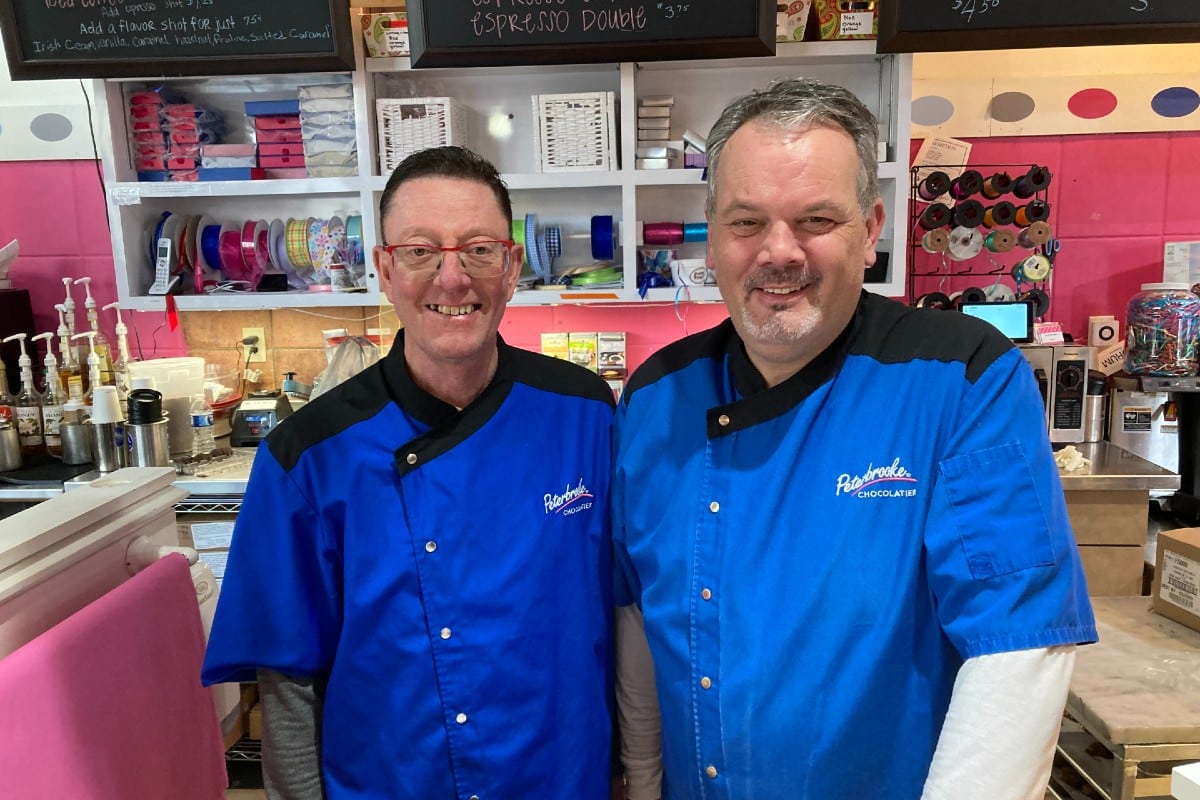
Peachtree Corners will soon lose one of its most iconic, popular and tasty businesses.
Peterbrooke Chocolatier, run by Geoffrey Wilson and Scott Gottuso, has been told by Peachtree Forum landlords, North American Properties and Nuveen Real Estate, that its lease will not be renewed. The last day of business will be July 25.
Meanwhile, Peachtree Forum is getting several new stores. They include Kendra Scott, Sucre, and The NOW Massage. Previously announced were Alloy Personal Training, Cookie Fix, Gallery Anderson Smith, Giulia, Lovesac, Nando’s Peri-Peri and Stretchlab. Wilson adds: “We are not in their big picture.”
Wilson has operated Peterbrooke at the Peachtree Forum for 14 years and Gottuso has been there nine years. They have made the chocolatier profitable and doubled sales. Wilson says: “We turned it around through community involvement and made relationships. We worked with the schools, gave donations, did a lot in the community, and made a difference. We produce most everything we sell in the shop, so it’s labor intensive. We make European-style chocolate treats from scratch from the very best ingredients, package it, make gift baskets, and also sell a lot of gelato.”
Key items include truffles, hand-made caramels, cherry cordials, chocolate-covered cookies and pretzels and strawberries hand-dipped in their own blend of chocolates. (They are all good!) One of Wilson’s and Gottuso’s most iconic products is chocolate popcorn. Once you try it, regular popcorn is tasteless. “We sell a lot of it.” Wilson adds: “Gelato sales have carried us in the summertime, since there are not many chocolate holidays in the summer.”
Peterbrooke now has five employees, and would like to have 10, but it is difficult to hire people with the skills in chocolatiering. A key part of its business is corporate companies, such as Delta Air Lines and Capital Insight. The Peachtree Corners’ Peterbrooke has corporate customers as far away as Cleveland, Ohio.
The operators were surprised when the Forum owners did not renew its five year lease. “The big decisions were made in Charlotte or Cincinnati, not locally,” Wilson feels. “We were no longer in their big picture. They want new and glitzy, shiny, fancy and trendy.”
The operators plan to start their own chocolate company, to be called “Scoffrey,” and initially sell online, plus have pop-up locations during holidays, and possibly have a booth in other merchants’ stores on occasions.
“Whatever we do would look different. We might rent a space somewhere close by so that people can still have the good chocolate experience with us, but we won’t have a regular audience walking by.”
Another element: the price of chocolate futures has spiked this year, with a bad crop production year. Wilson says: “That is key to our business and a huge cost increase. That doesn’t help.”
Wilson adds that the forced closing of the Peterbrooke location “is something like the death of a friend. But you go to the funeral and to the wake, and in six months or a year, It won’t be so bad.”
Have a comment? Send to: elliott@elliottbrack
Written by Elliott Brack
This material is presented with permission from Elliott Brack’s GwinnettForum, an online site published Tuesdays and Fridays. To become better informed about Gwinnett, subscribe (at no cost) at GwinnettForum
Related
Business
North American Properties Revitalizes Avenue East Cobb
Published
1 week agoon
April 16, 2024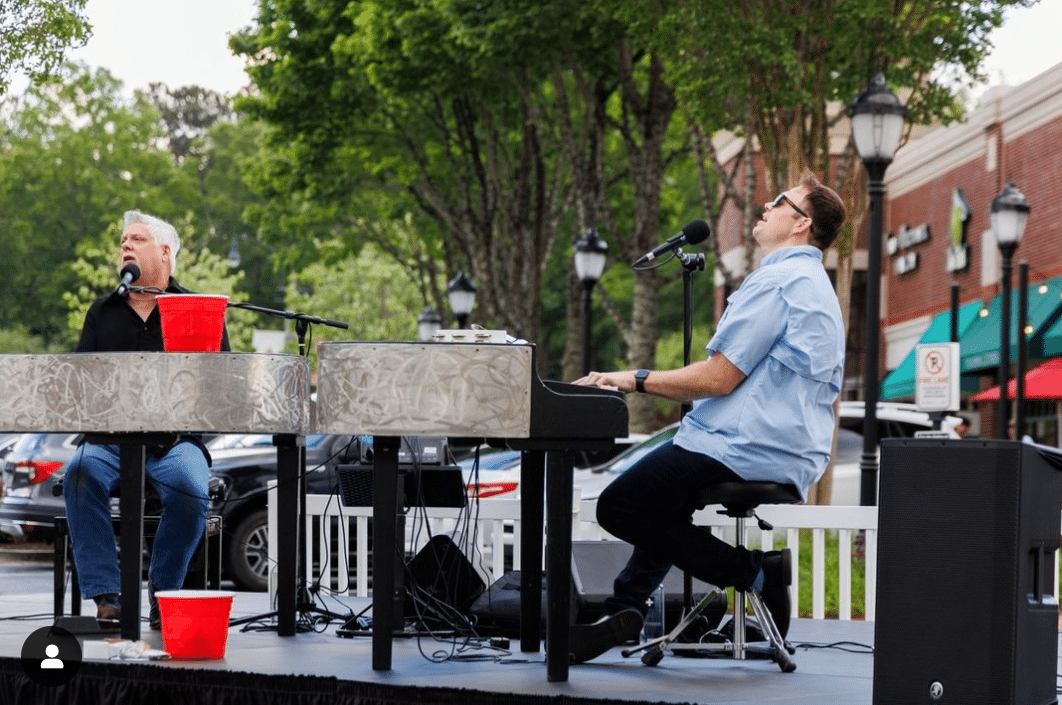
North American Properties (NAP) has revamped the Avenue East Cobb shopping center in Marietta, boosting its appeal to suburban residents seeking a more urban lifestyle. Now, it’s being honored as part of the Atlanta Business Chronicle‘s “Best in Atlanta Real Estate” coverage.
NAP is known for transforming properties like Atlantic Station, Colony Square and The Forum.
According to the Atlanta Business Chronicle, the redevelopment involved demolishing part of the main building to build a public plaza with a stage surrounded by restaurant patios.
A new concierge facility was also added, including a canopy for drop-offs. Additionally, smaller retail buildings were created for standalone tenants. The business mix was updated to include names like Warby Parker, Lululemon and Peach State Pizza.
NAP also increased community engagement by partnering with at least 10 local organizations for social events. These efforts have proven successful. Over the last two years, Avenue East Cobb has seen a 36% increase in sales per square foot thanks to a major rise in foot traffic.
More news from North American Properties can be found here.
Related
Business
North American Properties Secures 3 New Brands for The Forum
Published
2 weeks agoon
April 11, 2024
North American Properties (NAP) and Nuveen Real Estate announced three new businesses coming to The Forum Peachtree Corners (The Forum). The new brands include Kendra Scott, Sucré, and The NOW Massage.
“We’re excited to keep expanding our merchandising mix with more experiential concepts that motivate guests to extend their time on property. In addition to these new leases, several tenants are on track to open over the next few months, and we can’t wait to see the impact,” said Brooke Massey, director of leasing at NAP.
Here are the latest deals to be signed at The Forum:
Kendra Scott – Known for its plethora of accessories and customizable Color Bar experience, jewelry brand Kendra Scott blends classic designs with modern sophistication. Kendra Scott jewelry celebrates individuality and self-expression.
The growing brand has also donated over $50 million to local, national and international causes since its launch in 2010. The 2,284-square-foot space, situated next to Lovesac, opens later this spring, marking the retailer’s fourth location in the NAP portfolio.
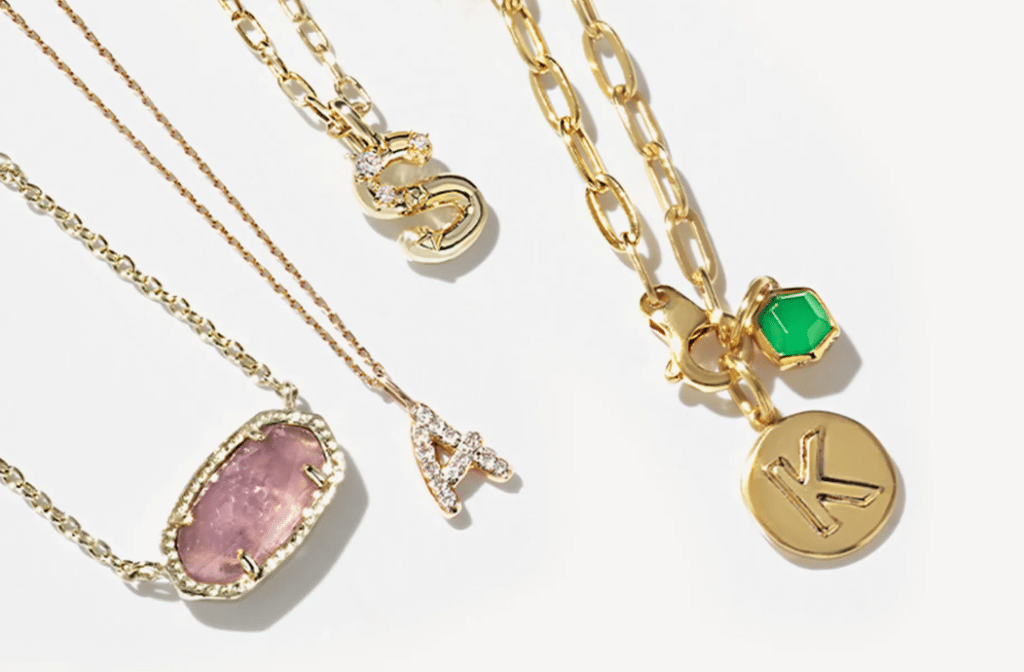
Sucré – Founded in New Orleans, Sucré is a gourmet patisserie known for its macarons, gelato and other handmade, French-inspired desserts.
The sweet boutique will occupy a 1,718-square-foot space on the north end of the property and is slated to open later this year. Georgia is the brand’s first out-of-state venture, with The Forum being its third metro Atlanta location and eighth overall.
The NOW Massage – This brand is helping people discover the healing benefits of massage therapy.
The customizable menu offers guests three signature massage styles and a variety of exclusive enhancements like Deep Tissue, Herbal Heat Therapy, Hemp Calm Balm, Gua Sha, Gliding Cupping and more. Located near Mojito’s, the 2,414-square-foot massage boutique debuts late summer.

These businesses join:
Alloy Personal Training (opening this month),
Cookie Fix (open),
Gallery Anderson Smith (opening this month),
Giulia (opening this spring),
Lovesac (open),
Nando’s Peri-Peri (coming winter 2024), and
Stretchlab (open).
Since acquiring the property in March 2022, NAP has executed 39 deals with new, existing and temporary tenants alike.
To stay up to date on the latest happenings at The Forum, follow on Facebook, Instagram, and X or visit theforumpeachtree.com.
Related
Read the Digital Edition
Subscribe
Keep Up With Peachtree Corners News
Join our mailing list to receive the latest news and updates from our team.
You have Successfully Subscribed!

North American Properties Secures 3 New Brands for The Forum

Exploring Israeli Innovation in the Smart City Sector with Einav Gabbay [Podcast]

Georgia United Methodist Foundation Announces Changes to Finance Team

North American Properties Revitalizes Avenue East Cobb

BRACK: Peachtree Corners to lose Peterbrooke Chocolatier

Spring Voting Will Determine Important Gwinnett School Board Elections

Local Non-profit Boy With a Ball Announces Dates for Upcoming Conference

Local Non-profit Boy With a Ball Announces Dates for Upcoming Conference

Spring Voting Will Determine Important Gwinnett School Board Elections

BRACK: Peachtree Corners to lose Peterbrooke Chocolatier

Georgia United Methodist Foundation Announces Changes to Finance Team

North American Properties Revitalizes Avenue East Cobb

Exploring Israeli Innovation in the Smart City Sector with Einav Gabbay [Podcast]

North American Properties Secures 3 New Brands for The Forum

April/May Events Going on at Gwinnett County Parks

Light up the Corners [Video]

Capitalist Sage: Business Leadership in Your Community [Podcast]

Cliff Bramble: A Culinary Adventure through Italy

Top 10 Brunch Places in Gwinnett County

A Hunger for Hospitality

THE CORNERS EPISODE 3 – BLAXICAN PART 1

Top 10 Indoor Things To Do This Winter

The ED Hour: What it takes to Remove Barriers from Education
Peachtree Corners Life
Topics and Categories
Trending
-
Podcast1 week ago
Exploring Israeli Innovation in the Smart City Sector with Einav Gabbay [Podcast]
-
Faith1 week ago
Georgia United Methodist Foundation Announces Changes to Finance Team
-
Business1 week ago
North American Properties Revitalizes Avenue East Cobb
-
Business6 days ago
BRACK: Peachtree Corners to lose Peterbrooke Chocolatier







